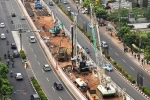This article has been translated by PwC Indonesia as part of our Indonesia Infrastructure News Service. PwC Indonesia has not checked the accuracy of, and accepts no responsibility for the content.
Investor Daily - Penggabungan Angkasa Pura I dan II disambut positif
31 May 2024
By Ichsan Amin
Jakarta, ID – The merger of Angkasa Pura (AP) I and Angkasa Pura II is directly affecting the public. A spokesperson for the Transportation Ministry, Adita Irawati, said that the merger was up to the state-owned enterprises (SOEs). However, the ministry as a regulator is ensuring that aviation services at airports will not be disrupted.
“Regarding the merger, it is the decision of the SOEs. We as a regulator only ensures that it will not disrupt public services,” she told Investor Daily.
Adita stated that the Transportation Ministry as a regulator ensures the merger adhered to good governance principles. She affirmed that, in addition to maintaining services for the public, the ministry would also ensure quality services for airlines and aviation stakeholders in terms of technicality and operations.
“The most important aspect is ensuring the permit aligns with good governance principles. In the event of a merger, subsidiaries holding licenses will continue to operate. This integration aims to provide more cohesive services for more positive and improved outcomes,” she added.
PT Angkasa Pura Indonesia Corporate Secretary Rahadian D. Yogisworo said that the merger was already in progress, as previously stated to the public. “It is expected to be completed in July 2024. The merger will have a positive impact on business and service developments,” he stated.
Previously, the government through the SOE Ministry established PT Aviasi Pariwisata (InJourney) to manage hotels, retail, and airports. This includes overseeing airports through Angkasa Pura Indonesia, which manages AP I and AP II. The merger of AP I and AP II is currently in progress and is expected to be completed this year.
Tariff standardisation
Indonesia National Air Carriers (INACA) Chairperson Denon Prawiraatmadja stated that the merger of AP I and AP II would not pose an issue for airlines. He emphasised that the most important aspect was standardising airport service tariffs for both airlines and passengers in the eastern and western regions.
“The same standardised tariff for the same service. This is what is important for us airlines. This allows Angkasa Pura to focus more on developing airport services for the public and explore other potential areas, such as the logistics sector, to provide more profit to the company,” he stated.
Denon added that it was crucial for Angkasa Pura to engage in various activities, such as attracting larger, especially international, airlines. Additionally, national airlines can be supported through improved facilities at airports.
“Airlines have no issue as long as services for passengers and airlines run smoothly. We will support this initiative as long as it benefits the airlines,” he added.
Meanwhile, aviation observer Gatot Rahardjo stated that the merger should be viewed positively as it enhances the quality of airport management in Indonesia, making it more competitive against neighbouring countries like Singapore and Malaysia.
“There is Angkasa Pura Indonesia. I believe this will enhance our competitiveness against neighbouring countries like Singapore and Malaysia,” Gatot said.
Gatot said that the merger needed time to integrate existing assets and human resources since each management has subsidiaries with different business focuses.
“It will take time. AP I and AP II each have their own culture, so the challenge lies in merging their assets and human resources in their subsidiaries,” he revealed.
More focused
The merger can bring more focus to managing airports in Indonesia. Until now, the public has only known airports in the western and eastern regions to be managed separately by AP I and AP II.
“There is an upside to this merger. It can bring more focus to managing airports in Indonesia. Currently, the western region is managed by AP II and the eastern region by AP I. AP II has an airport in Banyuwangi, while AP I manages Batam, although it is in cooperation with a third party. Batam has always competed against Kualanamu, so it can be more controlled to make it seem like they are competing. However, the real competition lies with Singapore and Kuala Lumpur.”
He explained that the merger was expected to address the government's initiative to reduce the number of international airports through the Transportation Ministry some time ago. This merger can further develop by implementing the hub and spoke scheme. “So, there is no more competition due to different management. We can also be more focused on how to develop the hub and spoke scheme more efficiently,” he stated.
Angkasa Pura Indonesia announced that the merger process of AP I and AP II was expected to be completed by July 2023 as the registration and operational permit adjustments have been completed.
AP I currently manages 16 airports in Indonesia, namely I Gusti Ngurah Rai Airport in Bali, Juanda Airport in Surabaya, Sultan Hasanuddin Airport in Makassar, Sultan Aji Muhammad Sulaiman Sepinggan Airport in Balikpapan, Frans Kaisiepo Airport in Biak, Sam Ratulangi Airport in Manado, Syamsudin Noor Airport in Banjarbaru, Ahmad Yani Airport in Semarang, Adisutjipti Airport in Yogyakarta, Yogyakarta International Airport in Kulon Progo, Adi Soemarmo Airport in Surakarta, Lombok International Airport in Praya, Pattimura Airport in Ambon, El Tari Airport in Kupang, Sentani Airport in Jayapura, and Hang Nadim Airport in Batam.
Meanwhile, Angkasa Pura II manages 20 airports in Indonesia, namely Soekarno-Hatta Airport (Tangerang), Halim Perdanakusuma Airport (Jakarta), Kualanamu Airport (Medan), Supadio Airport (Pontianak), Minangkabau Airport (Padang), Sultan Mahmud Badaruddin II Airport (Palembang), Sultan Syarif Kasim II (Pekanbaru), Husein Sastranegara Airport (Bandung), Sultan Iskandarmuda Airport (Banda Aceh), Raja Haji Fisabilillah Airport (Tanjungpinang), Sultan Thaha Airport (Jambi), Depati Amir Airport (Pangkalpinang), Silangit Airport (North Tapanuli), Kertajati Airport (Majalengka), Banyuwangi Airport (Banyuwangi), Tjilik Riwut Airport (Palangka Raya), Radin Inten II Airport (Lampung), H.A.S Hanandajoeddin Airport (Tanjung Pandan), Fatmawati Soekarno Airport (Bengkulu), and Jenderal Besar Soedirman Airport (Purblingga).
Angkasa Pura I and II are part of the tourism and aviation SOE holding PT Aviasi Pariwisata Indonesia (Persero) that is known as InJourney as a corporate brand and the subholding PT Angkasa Pura Indonesia that is branded as InJourney Airports.


















